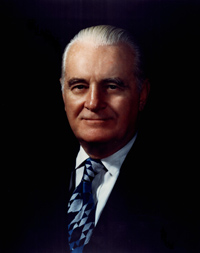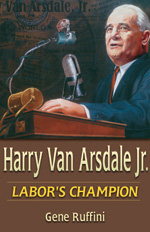



Harry Van Arsdale, Jr., Labor's Champion By: Gene Ruffini
Book Review By: Thomas J. Germano
Director, Center for Labor/Management
Relations and Dispute Resolution
Oakdale, NY
Harry Van Arsdale, Jr.: Labor’s Champion. By Gene Ruffini. Foreword by Theodore Kheel. Lebanon, Pa.: M.E. Sharpe, 2002. 304 pp. ISBN 0-7656-1044-2
In the Foreword to this book, noted labor mediator Theodore Kheel refers to Harry Van Arsdale, Jr., as a “practical realist.” In the book’s preface, the author, Gene Ruffini, calls Van Arsdale the most powerful labor leader in New York City, a champion, a legend accorded the respect of a saint. By the time I got to the first chapter, I expected this biography to be little more than an experience in public relations hyperbole. However, after reading the book, I would describe Van Arsdale as a pragmatist, visionary, and icon, and one of the most powerful, influential, and productive leaders in the history of American trade unionism.
The struggles, influence, and accomplishments of Van Arsdale are so far-reaching that they continue to have a major impact on labor-management relations. Speeches and programs made and initiated by Van Arsdale more than 50 years ago are as relevant in today’s world as they were visionary a half-century ago.
The author details a number of strategies and tactics applied by Van Arsdale as he struggled to rid the International Brotherhood of Electrical Workers (IBEW) of corruption and to overcome the heavily biased anti-union reporting of the media. The strikes and boycotts he managed to lead despite such impediments resulted in collective bargaining agreements and union organizing campaigns; and yet, notwithstanding his readiness to fight when necessary, ultimately a more important means by which he bettered union members’ lot—shortening their work hours while increasing their pay and benefits—was by paving the way for an unprecedented level of labor-management cooperation.
The book traces the roots of Van Arsdale’s family from the Revolutionary War to twentieth-century New York City, where his father, an electrical worker who was a staunch union advocate, strove to improve the lot of his fellow workers by fighting not only contractors, but also factions within the electricians’ union itself. The author spares neither union nor individuals in recounting these struggles.
The disorganized, greedy, corrupt, and sometimes violent activities of various union members and leaders are exposed. Even the arrests, convictions, and jail time of the book’s hero Harry Van Arsdale are detailed, as are the eventual overturning of his criminal convictions.
The author devotes much of the book to a number of historical strikes and organizing drives in New York City and the nation. He focuses on the critical roles Van Arsdale played in these events, which include conflicts with department store giants Gimbel Brothers and R. H. Macy, United Electric, New York Edison, the Lincoln Tunnel project, the city-owned Independent Subway System, Brooklyn Edison, Bronx Gas and Electric Company, and Con Edison. Also described are Van Arsdale’s important part in the Local 1199 drive to organize health and hospital workers, the United Federation of Teachers strike, the New York City sanitation strike, the United Farm Workers organizing campaign, the air traffic controllers’ strike, and the strike and national boycott of the Farah Manufacturing Company.
Van Arsdale perfectly illustrates former Speaker of the House Tip O’Neill’s statement that “all politics is local.” While Van Arsdale’s political access and influence reached the highest levels of government, unions, and corporate America, his power base was always New York City, where he served as Business Manager of Local 3 of the IBEW and President of the New York City Central Labor Council.
Reading this book, which at times appears to be more of a novel and twentieth-century labor history text than a biography, one cannot help but be overwhelmed by the vision, tenacity, dedication, integrity, and ultimately the accomplishments of this truly astonishing labor leader. Among many other things, he led the fight for a 7-hour day and 35-hour work week in 1934; established a Joint Labor-Management Industry Board based on his belief that labor and management could accomplish more benefits for each other working together than working separately; organized the entire electrical industry in New York City; established the first employer-paid pension plan in 1937; formed the first multi-employer pension plan for the building trades in America; constructed inexpensive cooperative housing for Local 3 members; established a loan fund, death benefit plan, and insurance and supplemental pay for members during illness or injury; created a medical, dental, and employee assistance program for the union; established scholarships, lecture programs, cultural events, libraries, and retirement enrichment programs; purchased and developed a rest and convalescent home for Local 3 members that was expanded and transformed into an educational center and a summer camp for children of members, disadvantaged youths, and Boy Scouts; was the driving force behind the formation of the Labor College of the State University of New York, the first accredited labor college in the United States; in 1962 negotiations, gained Local 3 electricians a 5-hour work day (meaning, in practice, that they worked 5 hours per day at a straight time rate of pay, then a sixth mandatory and seventh voluntary hour at overtime rates) and, for their families, an educational trust fund; funded a program to help handicapped and disabled workers find jobs; spearheaded voter registration drives; formed community alliances with racial, ethnic, religious, business, and social agencies; created the National Council of Unemployed for union and non-union workers; opened the union and all of its benefits to African-American, Latino, Asian, and all other minority and immigrant populations; and advocated for civil rights with Martin Luther King, Bayard Rustin, and A. Philip Randolph.
The author makes a convincing case that Van Arsdale’s life was his work and the union was his life. “Without a union,” Van Arsdale said—speaking as a skilled and hard-working craftsman, not just a union activist—“a worker has no chance.” He believed that the only purpose of the union is to serve the membership, and viewed the trade union movement as the social and economic conscience of our nation and the only means by which American workers could confidently provide a better life for their families.
Van Arsdale understood that the key to successful labor organization was the systematic involvement of the greatest possible number of its members, and he believed the best way to empower members and the union was through education. He mandated that every member of Local 3 attend the labor college and achieve no less than an associate degree in a curriculum that encompassed not only labor studies but liberal arts as well.
In the book’s Afterword, Hy Greenblatt, President of the Harry Van Arsdale, Jr. Memorial Association, writes,
To sum it up, if I had to say in one word what Harry held most dear, it would be education. It was what Harry was most concerned with and he saw education as the means to help find solutions to the challenges that will continue to face working men and women. He saw education as the justification for higher standards and ultimately he saw education as the path to a better and more just society.
The author quotes one of Van Arsdale’s closest friends who spoke with Harry just before he died:
Before he passed away, I visited him and he was in bed and he could hardly talk. He motioned me to come over to him and I pressed my ear against his mouth and he said, “Tell me the truth. How many students do we have at the Labor College?” He knew he was dying and he wanted to know how many students there were at the College.
After more than 60 years in the labor movement, Van Arsdale died at age 80 on February 16, 1986. In a fitting tribute to a man who believed so much in education and the trade union movement, Empire State College’s Center for Labor Studies, State University of New York, was renamed the Harry Van Arsdale, Jr. School of Labor Studies; and on December 5, 2001, Harry Van Arsdale, Jr. was inducted into the AFL-CIO’s Labor International Hall of Fame.
This book leaves no doubt that Van Arsdale’s reputation as labor’s champion is well deserved. But he was more than that: he was and is a champion and role model for the entire human race—which , the author tells us, Harry often wished everyone would someday rejoin.
Thomas J. Germano
Director, Center for Labor/Management
Relations and Dispute Resolution
Oakdale, New York

